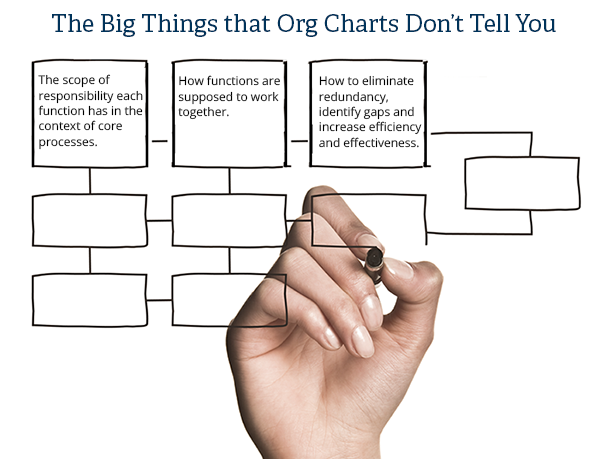What Is Your Marketing Org Chart Telling You?
- Org charts provide a snapshot of the current state of an organization’s structure
- They don’t show the scope of responsibility each function has in the context of core processes
- They don’t show how functions are supposed to work together
When it comes to organizational design, your marketing org chart probably isn’t telling you very much, and it certainly isn’t telling you the most important things you need to know.
Org charts are great if you want a static view of an organization that reflects the presence or absence of functions, the overall reporting structure, and the quantities, names or titles of people in each function. Not bad if all you need is a snapshot of the current state of an organization’s structure, but not nearly enough if you are planning to make even minor changes to that organization.
The big things that org charts don’t tell you:
 The scope of responsibility each function has in the context of core processes. For example, as you plan, build and run a campaign, your org chart won’t tell you much of anything about the responsibilities of communications vs. field marketing vs. marketing operations vs. product marketing. It also doesn’t tell you how those responsibilities change in different processes, such as those required to launch new offerings, create and manage content assets, or enable sales or partners.
The scope of responsibility each function has in the context of core processes. For example, as you plan, build and run a campaign, your org chart won’t tell you much of anything about the responsibilities of communications vs. field marketing vs. marketing operations vs. product marketing. It also doesn’t tell you how those responsibilities change in different processes, such as those required to launch new offerings, create and manage content assets, or enable sales or partners.
- How functions are supposed to work together. When should product marketing and field marketing collaborate during campaign planning, building and operations? What are the inputs a global campaign team needs from marketing operations to effectively fulfill its responsibilities? You’ll find no answers to these types of questions in an org chart.
- How to eliminate redundancy, identify gaps and increase efficiency and effectiveness. Because they provide only a static view that doesn’t show processes, capabilities, scope of responsibility, or points of interlock, org charts are usually worse than useless when leaders are trying to drive improvement through organizational design (which always includes process design). They add no valuable insight while they do present a great opportunity for leaders to be distracted by legacy reporting structures, team members’ personalities, and internal politics before they even try to design the optimal scenario.
If you change one function’s scope of responsibility or add a new skill or capability, how does it impact other functions? If you implement a new process or initiative, how can you effectively map out the responsibilities, interlocks and dependencies across all functions engaged in that process or initiative? How can you effectively analyze and optimize any marketing process?
The answer to all of these questions is to create a different view of your marketing organization. SiriusDecisions has developed the Marketing Ecosystem both as a way to view organizations differently and as a tool to rapidly and confidently analyze, make changes, and optimize an organization in the context of core processes. By showing functions, scope of responsibility, points of interlock, inputs/outputs and other key process elements, the Marketing Ecosystem enables systems thinking in organization design. This, in turn, speeds decisions, minimizes problems and supports effective change management.
The best thing about using a Marketing Ecosystem view is that it also enables fast and accurate integration with sales and product management ecosystems. The result is the Revenue Ecosystem, which is the secret of how top-performing B2B businesses operationalize alignment as they go to market.